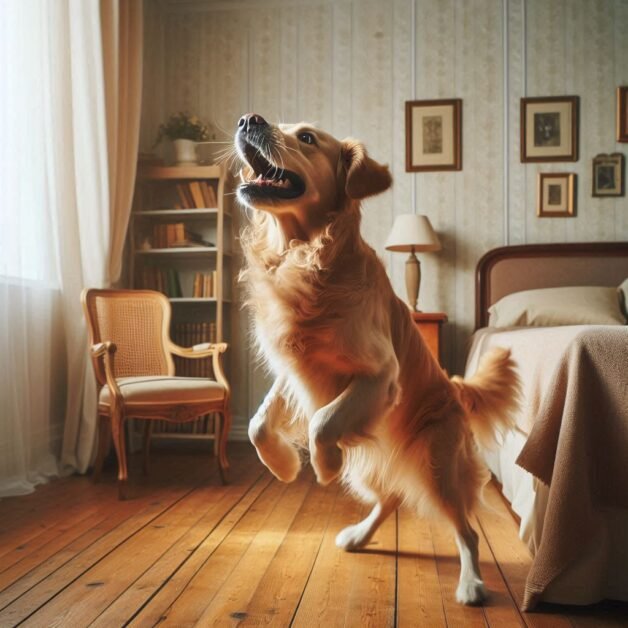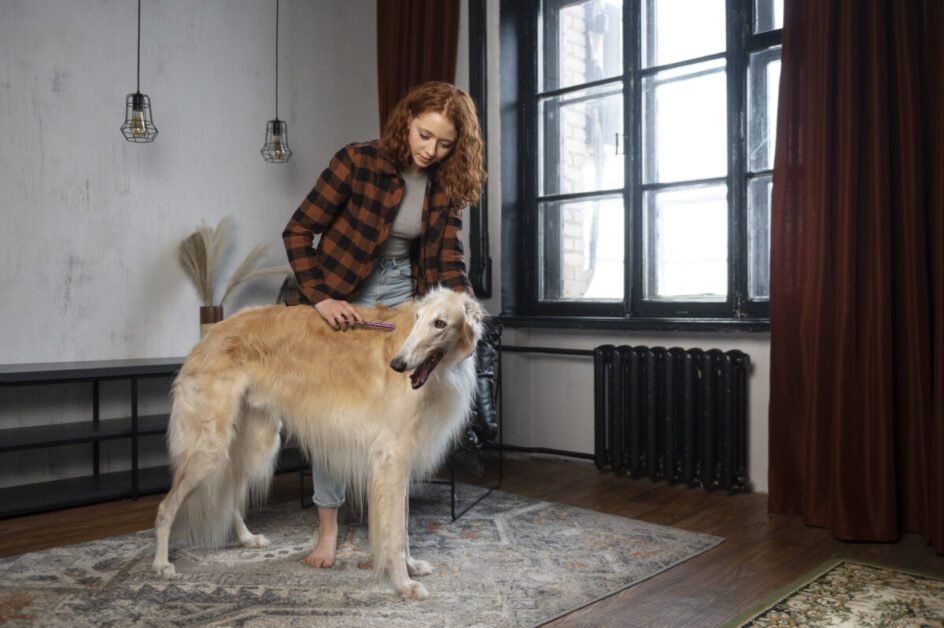Is your dog terrified of thunderstorms, fireworks, or even the vacuum cleaner? Noise anxiety in dogs is a common but distressing condition that can turn your once fearless companion into a trembling, fearful pup. Understanding the causes, recognizing the symptoms, and finding effective solutions are crucial steps in helping your furry friend regain their confidence and peace of mind.
In this comprehensive guide, we’ll delve into the root causes of noise anxiety, from genetic predispositions to traumatic experiences. We’ll also explore the telltale signs that your dog might be suffering from this condition, such as excessive barking, hiding, or destructive behavior.
Most importantly, we’ll provide practical solutions, including behavioral training, natural remedies, and dietary changes, to help your dog overcome their fears. Don’t let noise anxiety steal your dog’s joy—discover how you can make a positive difference in their life today.
Table of Contents
1. Breed Predisposition to Anxiety
Breed predisposition to anxiety is a crucial aspect to consider when understanding why some dogs are more prone to experiencing noise anxiety than others. While it is important to remember that individual dogs within a breed can vary in temperament and anxiety levels, certain breeds are known to have a higher likelihood of developing anxiety-related issues.
One example of a breed with a predisposition to anxiety is the Border Collie. Known for their intelligence and intense focus, Border Collies have a strong herding instinct that can contribute to anxiety when faced with loud noises. The breed’s sensitivity and high energy levels make them more susceptible to noise-induced anxiety, particularly during situations such as thunderstorms or fireworks. It is not uncommon to see these dogs displaying symptoms of trembling, excessive barking, and restlessness when exposed to loud noises. However, it is crucial to note that not all Border Collies will develop anxiety, and proper socialization and training can greatly reduce the likelihood of anxiety-related issues.

Another breed that can be predisposed to anxiety is the Chihuahua. Despite their small size, Chihuahuas are known for their strong-willed and protective nature, which can make them more prone to anxiety. This breed tends to form strong bonds with their owners and can become highly attached, resulting in separation anxiety. Additionally, their alert and vigilant nature can make them more sensitive to noise triggers, leading to symptoms such as excessive barking, trembling, and seeking comfort by hiding. It is important for Chihuahua owners to provide a secure and calm environment, as well as proper training and socialization, to help reduce anxiety levels and promote their overall well-being.
Understanding the breed predisposition to anxiety is essential when it comes to identifying and addressing noise anxiety in dogs. While certain breeds may have a higher likelihood of developing anxiety-related issues, it is important not to generalize, as individual temperament and life experiences also play a significant role in a dog’s anxiety levels.
2. Symptoms of Noise Anxiety in Dogs
Understanding the symptoms of noise anxiety in dogs is crucial for providing the right care and support. Here are some common signs to watch for:
Trembling and Shaking
Trembling and shaking are frequent physical manifestations of noise anxiety in dogs. When exposed to loud, sudden noises like thunderstorms or fireworks, many dogs experience intense fear and anxiety, which can result in uncontrollable trembling or shaking. This response is often seen in smaller breeds such as Chihuahuas and Yorkshire Terriers, whose petite size makes them more vulnerable to feeling overwhelmed by abrupt sounds. Additionally, breeds with sensitive temperaments, such as Shetland Sheepdogs and Labrador Retrievers, may also exhibit trembling and shaking due to their predisposition to anxiety.
Breeds Prone to Trembling and Shaking
| Breed | Size | Temperament |
|---|---|---|
| Chihuahua | Small | Anxious |
| Yorkshire Terrier | Small | Sensitive |
| Shetland Sheepdog | Medium | Sensitive |
| Labrador Retriever | Large | Sensitive |
During these episodes, dogs may also display other signs of distress, such as flattening their ears, tucking their tails, or hunching their bodies. Recognizing these signals is essential for providing appropriate support and reassurance.
Excessive Barking or Howling
Excessive barking or howling is another common symptom of noise anxiety in dogs. When startled by loud noises, dogs often vocalize their fear. This behavior is particularly noticeable in breeds known for their vocal nature, such as Beagles and Siberian Huskies. These dogs may bark or howl excessively, seemingly trying to alert their owners or seek reassurance. Persistent and uncontrollable barking or howling can cause significant stress for both the dog and the owner.

Breeds Prone to Excessive Barking or Howling
- Beagle
- Siberian Husky
- Chihuahua
- Toy Poodle
- German Shepherd
Understanding the difference between regular alert barking and anxiety-induced barking is crucial for addressing this symptom effectively.
Restlessness and Pacing
Restlessness and pacing are common behaviors in dogs experiencing noise anxiety. Anxious dogs often appear unable to settle down and may constantly move about, pacing back and forth or circling a particular area. This behavior is frequently observed in high-energy breeds like Border Collies, which thrive on mental and physical stimulation. Similarly, small breeds like Chihuahuas, known for being highly alert and easily startled, may exhibit restlessness and pacing during times of noise anxiety.
Breeds Prone to Restlessness and Pacing
| Breed | Energy Level | Sensitivity to Noise |
|---|---|---|
| Border Collie | High | High |
| Chihuahua | High | High |
Restlessness and pacing can also be a coping mechanism for dogs to alleviate their anxiety. However, prolonged pacing can lead to exhaustion and muscle fatigue, making it essential to create a safe and secure environment for anxious dogs.
Hiding or Seeking Comfort
Hiding or seeking comfort is a common response in dogs with noise anxiety. When faced with loud or unpredictable noises, some dogs may retreat to hiding spots where they feel secure. This behavior is often seen in small breeds like Chihuahuas and Yorkshire Terriers, who may seek refuge under furniture or in small, enclosed spaces. Conversely, larger breeds like Golden Retrievers and Labrador Retrievers may seek comfort by cuddling up to their owners or pressing against them for reassurance.
Breeds Prone to Hiding or Seeking Comfort
Providing a designated safe space, such as a quiet room or a cozy dog crate, can offer a sense of security for anxious dogs. Equipping the safe space with familiar and comforting items, like their favorite bedding or toys, can further enhance the feeling of safety. Additionally, using white noise or playing soothing music can help drown out disturbing sounds, creating a more calming atmosphere.
Destructive Behavior
Destructive behavior is a common symptom of noise anxiety in dogs. When overwhelmed by loud noises, dogs may resort to destructive behaviors as a coping mechanism. This can include chewing on furniture, scratching doors or walls, or even digging up the yard. For example, Labrador Retrievers, known for their energetic and playful nature, may exhibit destructive behavior when anxious.

Common Destructive Behaviors
- Chewing on furniture
- Scratching doors or walls
- Digging up the yard
Addressing noise anxiety in dogs requires a comprehensive approach that includes creating a safe environment, providing appropriate support, and using techniques to alleviate anxiety. Recognizing the symptoms and understanding the specific reactions of different breeds can help owners tailor their approach and provide the necessary care for their beloved furry companions.
3. Effects of Noise Anxiety on Dogs
Tremors wrack their body, causing their paws to quiver uncontrollably. The noise in the environment has triggered their anxiety, leaving them trembling and shaking with fear. Dogs, particularly certain breeds, are more prone to experiencing noise anxiety, which can have significant effects on their overall well-being.
One of the common symptoms of noise anxiety in dogs is excessive barking or howling. When faced with loud or unfamiliar sounds, some dogs may resort to vocalizing their distress. For example, breeds like the Chihuahua and Miniature Schnauzer are known to be more vocal and may respond to noise anxiety by incessantly barking or howling. This behavior not only signals their anxiety but can also disrupt their surroundings and cause additional stress for both the dog and their human caregivers.
Restlessness and pacing are another noticeable effect of noise anxiety in dogs. An anxious dog may become unable to settle down, constantly moving from one place to another in search of comfort and security. This behavior can be observed in breeds such as the Border Collie and Australian Shepherd, known for their high energy levels and propensity for anxiety. It is vital to understand that this restlessness is not simply restlessness; it is a manifestation of their anxiety and an indication that they are struggling to cope with the noise around them.
Dogs with noise anxiety may exhibit hiding or seeking comfort as a coping mechanism. They may retreat to small, enclosed spaces, such as under furniture or in closets, in an attempt to shield themselves from the overwhelming noise. Breeds like the Cavalier King Charles Spaniel and Bichon Frise, known for their affectionate nature, may seek close contact with their human companions during these stressful moments. This behavior is driven by their instinctual need to feel safe and protected in the face of anxiety-inducing sounds.
Additionally, destructive behavior can also be a consequence of noise anxiety in dogs. When overwhelmed and unable to find relief from the distressing sounds, some dogs may resort to destructive actions like chewing furniture, digging holes, or tearing apart household items. Breeds with a high prey drive, such as the Jack Russell Terrier or Labrador Retriever, may exhibit such behavior more frequently due to their innate intensity and need for mental and physical stimulation.
To truly understand the impact of noise anxiety on dogs, it is crucial to consider not only its physical health implications but also the emotional and behavioral changes it brings. By delving deeper into these effects, we can gain a comprehensive understanding of the toll that noise anxiety takes on a dog’s overall well-being and quality of life.
4. Physical Health Implications
Noise anxiety in dogs doesn’t just affect their emotional well-being; it also has significant physical health implications. Dogs experiencing noise anxiety often show symptoms such as increased heart rate, rapid breathing, and elevated blood pressure. This prolonged state of stress can lead to various health issues, including digestive problems, a weakened immune system, and even cardiovascular disorders.
Certain dog breeds are more prone to developing physical health complications due to noise anxiety. For instance, small breeds like Chihuahuas and Yorkshire Terriers are particularly susceptible to heart problems when exposed to prolonged stress. These breeds have a higher likelihood of experiencing arrhythmias and heart murmurs, which can have long-term effects on their cardiovascular health. Similarly, breeds with short muzzles, such as Bulldogs and Pugs, may struggle with breathing during episodes of heightened anxiety, putting them at risk of respiratory distress and even collapse.
The constant state of tension caused by noise anxiety can also weaken a dog’s immune system, making them more vulnerable to infections and illnesses. Studies have shown that dogs with chronic stress are more prone to developing urinary tract infections, skin allergies, and gastrointestinal issues. Over time, these health problems can significantly impact a dog’s physical well-being and interfere with their daily activities and overall quality of life.
Understanding the physical health implications of noise anxiety is crucial for providing comprehensive care to affected dogs. By recognizing these symptoms and addressing them promptly, pet owners can help mitigate the adverse effects of noise anxiety and improve their dogs’ overall health and happiness.
5. Emotional and Behavioral Changes
Emotional and behavioral changes are often observed in dogs with noise anxiety. Each dog may exhibit a unique set of symptoms, but there are some common patterns that can be seen across different breeds. For instance, when faced with a triggering noise, a dog may become increasingly anxious, leading to restlessness and pacing. This behavior is often accompanied by trembling and shaking, as the dog’s body physically reacts to the stress and fear it is experiencing.
Another common manifestation of noise anxiety is excessive barking or howling. Dogs may vocalize their distress in an attempt to communicate their discomfort or seek reassurance from their owners. This behavior can be particularly challenging in apartment settings or densely populated areas, where noise disturbances are more frequent. Additionally, some dogs may demonstrate destructive behavior as a response to their anxiety. Chewed furniture, scratched doors, and destroyed belongings can be signs of a dog attempting to alleviate their stress through these destructive outlets.
In terms of emotional changes, dogs with noise anxiety may exhibit heightened fear or heightened sensitivity to certain environmental stimuli. They may become hyper-vigilant, constantly on high alert for any potential noise triggers. This state of anxiety can have a profound impact on the dog’s overall quality of life, as they may become increasingly withdrawn, lose interest in activities they used to enjoy, or show signs of depression. It is not uncommon to observe changes in a dog’s appetite or sleep patterns as well. It is important to note that these emotional and behavioral changes can vary from one dog to another, as each individual may have their own unique response to noise anxiety.
6. Impact on Quality of Life
Dogs suffering from noise anxiety experience a range of emotional and physical symptoms that can significantly impact their overall quality of life. The constant fear and stress caused by loud noises can lead to an array of negative consequences. Firstly, noise anxiety can severely affect their emotional well-being, causing them to become anxious, irritable, and fearful. They may exhibit excessive panting, trembling, or shaking as they try to cope with their heightened anxiety levels. Some breeds, such as the Chihuahua and Cavalier King Charles Spaniel, are more genetically predisposed to anxiety, exacerbating the impact on their quality of life.
In addition to emotional changes, noise anxiety can also manifest in behavioral disruptions that can be distressing for both the dogs and their owners. Dogs experiencing noise anxiety may engage in excessive barking or howling, trying to vocalize their fear and seek comfort. This constant vocalization can not only interrupt their own peace but also disturb the harmony of the household. Furthermore, restlessness and pacing are common signs of noise anxiety, as dogs struggle to find a place of solace amidst the overwhelming noise. This ceaseless movement and inability to settle can lead to exhaustion and prevent them from enjoying their regular activities, further compromising their quality of life.
Additionally, some dogs may resort to hiding or seeking constant reassurance and physical contact from their owners as a means of alleviating their anxiety. The turmoil caused by noise anxiety can be particularly evident in dogs with a strong attachment to their human companions, such as the Labrador Retriever or the Border Collie. Consequently, this dependence on constant comfort-seeking can exert a strain on the bond between the owner and their canine companion, negatively impacting their relationship and overall satisfaction.
7.Solutions for Noise Anxiety in Dogs
Creating Safe Spaces:
One effective solution for managing noise anxiety in dogs is to create a safe and secure space for them to retreat to during times when they feel overwhelmed by loud noises. This can be as simple as designating a specific room or area in the house where the dog feels most comfortable and at ease. It is important to ensure that this space is free from distractions and noise, providing a sense of calm and relaxation for the dog.
Adding familiar items such as their bed, blankets, and toys can help further create a sense of security. Additionally, utilizing white noise machines or soothing music can help drown out intrusive noises and provide a calming environment. Dogs are sensitive to their environment, and having a designated safe space can go a long way in reducing their anxiety during stressful situations.
Desensitization and Counterconditioning:
Another effective approach to managing noise anxiety in dogs is through desensitization and counterconditioning techniques. This involves gradually exposing the dog to the noise that triggers their anxiety in a controlled and positive manner, while pairing it with something enjoyable or rewarding. For example, if a dog is fearful of thunderstorms, a veterinarian may recommend playing a recording of distant thunder at a low volume and simultaneously giving the dog treats or engaging them in a favorite activity.

Over time, the volume of the noise is gradually increased, while continuing to provide positive reinforcement. This gradual exposure helps the dog develop a positive association with the previously anxiety-inducing noise, ultimately reducing their fear and anxiety response. It is crucial to work with a professional trainer or behaviorist when implementing desensitization and counterconditioning techniques to ensure safety and effectiveness for both the dog and their owner.
Creating Safe Spaces
Creating safe spaces is an important step in helping dogs with noise anxiety feel more secure and calm during stressful situations. One effective way to create a safe space is by designating a specific area in your home where your dog can retreat to whenever they feel anxious or overwhelmed. This safe space should be quiet, secluded, and comfortable, providing a sense of security for your furry friend.
When choosing a location for the safe space, consider your dog’s preferences and behavior. Some dogs may prefer a small, enclosed space like a crate or a cozy corner in a room, while others may feel more at ease in an open area with a designated bed or blanket. It’s crucial to ensure that the safe space is easily accessible for your dog and free from any potential triggers or noises that may contribute to their anxiety.

To enhance the calming effect of the safe space, you can also add items that provide comfort and familiarity. This can include their favorite toys, a piece of clothing with your scent, or a cozy blanket they can snuggle up in. Additionally, playing soothing background music or using a white noise machine can help drown out external noises and create a more relaxing environment for your anxious dog.
When introducing the safe space to your dog, it’s essential to make it a positive experience. Encourage them to explore and spend time in the safe space by using treats or praise as rewards. By associating the safe space with positive experiences, your dog will learn to seek solace in this area whenever they’re feeling anxious.
Remember that every dog is unique, and what works for one breed may not be as effective for another. For example, some breeds, like the Border Collie, may prefer a safe space with minimal visual stimulation to avoid further sensory overload. On the other hand, breeds like the Golden Retriever may benefit from a safe space that allows them to have a view of the surroundings, helping them feel more in control and less vulnerable.
Creating a safe space for your dog can significantly alleviate their noise anxiety and provide them with a sense of security during stressful situations. By tailoring the safe space to your dog’s specific needs and preferences, you can help them find comfort and peace in the midst of loud or chaotic environments.
Desensitization and Counter conditioning
Desensitization and counterconditioning are two effective techniques used to help dogs with noise anxiety. Desensitization involves gradually exposing the dog to the source of noise that triggers their anxiety, starting with low volume or distance, and slowly increasing either over time. This process helps the dog build tolerance and reduce their fearful response.
For example, if you have a Border Collie who becomes anxious during thunderstorms, you may begin by playing a recording of distant thunder at a very low volume. As your dog becomes more comfortable with this level of noise, you can gradually increase the volume. Over time, they can learn to associate the sound of thunder with a more positive response.
Counterconditioning is another technique that can be used alongside desensitization. It involves teaching the dog to associate the feared noise with something positive, such as treats or playtime. This helps to change the emotional response from fear to a more positive or neutral state.
For instance, if you have a Poodle that becomes anxious with fireworks, you can pair the sound with something enjoyable like a special treat or a game of fetch. Eventually, the dog may start to look forward to the sound of fireworks because they associate it with positive experiences.
Both desensitization and counterconditioning require consistency, patience, and practice. It’s essential to start with small steps and gradually increase the difficulty level as your dog becomes more comfortable. It’s also crucial to create a safe and calm environment during the training process to minimize stress on your furry friend.
8. Professional Help and Medications
When dealing with anxiety in dogs, including noise anxiety, professional help can be invaluable. Consulting with a veterinarian or a certified veterinary behaviorist is often the first step. These professionals can help identify the type of anxiety your dog is experiencing and its potential triggers. They can also rule out any underlying health issues that might be contributing to the anxiety.

For severe cases, a veterinary behaviorist might recommend a combination of behavioral therapy and medication. Behavioral therapy can include techniques like desensitization and counter-conditioning, which help your dog gradually become less sensitive to anxiety triggers. A certified dog trainer can also provide specialized training to help manage anxiety-related behaviors.
Medications can be an effective part of the treatment plan for dogs with anxiety. For noise anxiety, veterinarians often prescribe medications such as benzodiazepines (e.g., Alprazolam) to help reduce acute anxiety during events like thunderstorms or fireworks. Other medications that might be prescribed include:
- Fluoxetine (Prozac): An SSRI that helps balance serotonin levels in the brain, reducing overall anxiety.
- Clomipramine (Clomicalm): A tricyclic antidepressant used to treat separation anxiety and other anxiety disorders.
- Trazodone: Often used as an adjunctive treatment to help with anxiety and promote calmness.
- Clonidine: Used to manage noise phobias and other anxiety-related behaviors.
- Dexmedetomidine (Sileo): An oromucosal gel specifically approved for the treatment of canine noise aversion.
In addition to medication, natural remedies and dietary changes can also play a significant role in managing anxiety. Products like Honest Paws CBD Oil can help calm your dog naturally. Calming supplements such as Zesty Paws Calming Bites contain ingredients like chamomile and valerian root, which are known for their soothing effects.
Creating a safe and comforting environment is also crucial. Using a white noise machine can help mask external sounds that trigger anxiety. Providing anxiety-relieving toys like the SmartPetLove Snuggle Puppy Behavioral Aid Toy and the KONG Classic Dog Toy can offer comfort and mental stimulation.
If your dog is struggling with anxiety, don’t hesitate to seek professional help. Combining professional guidance with medications and natural remedies can make a significant difference in your dog’s quality of life. Your love and support, along with the right treatment plan, can help your furry friend overcome anxiety and lead a happier, healthier life.
FAQs about noise anxiety in Dogs
What breeds are more prone to anxiety?
Certain breeds, such as Border Collies, German Shepherds, and Cocker Spaniels, have a higher predisposition to anxiety.
What are the symptoms of noise anxiety in dogs?
Dogs with noise anxiety may exhibit trembling and shaking, excessive barking or howling, restlessness and pacing, hiding or seeking comfort, and destructive behavior.
How does noise anxiety affect dogs?
Noise anxiety can have physical health implications, including increased heart rate and blood pressure. It can also lead to emotional and behavioral changes, impacting a dog’s overall quality of life.
What are the physical health implications of noise anxiety in dogs?
Dogs with noise anxiety may experience increased heart rate, elevated blood pressure, and stress-related conditions like digestive issues or even immune system suppression.
How does noise anxiety impact a dog’s emotional and behavioral state?
Dogs with noise anxiety may display changes in behavior, such as increased aggression or clinginess, and may become emotionally distressed, leading to a decrease in overall well-being.
How does noise anxiety affect a dog’s quality of life?
Noise anxiety can significantly impact a dog’s quality of life, causing constant stress and fear, limiting their ability to enjoy regular activities, and potentially leading to social isolation.
What are some solutions for noise anxiety in dogs?
Creating safe spaces for the dog, implementing desensitization and counterconditioning techniques, and seeking professional help or considering medications can help alleviate noise anxiety in dogs.
How can I create a safe space for my dog with noise anxiety?
Provide a quiet and comfortable area for your dog, using familiar bedding, toys, and soothing music. Consider using a crate or a designated room where the dog feels secure during noisy events.
What is desensitization and counterconditioning for noise anxiety?
Desensitization involves gradually exposing the dog to noise triggers in a controlled and positive way, while counterconditioning focuses on changing the dog’s emotional response to those triggers.
When should I consider seeking professional help for my dog’s noise anxiety?
If your dog’s noise anxiety is severe, persistent, or significantly impacting their quality of life, it is advisable to seek help from a professional, such as a veterinarian or a certified dog behaviorist.
Are there any medications available to help with noise anxiety in dogs?
Yes, certain medications, such as anti-anxiety medications or sedatives, may be prescribed by a veterinarian to alleviate the symptoms of noise anxiety in dogs. It is best to consult with a professional before considering medications.
Can I give my dog over-the-counter medications for noise anxiety?
No, it is not recommended to administer any over-the-counter medications to dogs without the guidance of a veterinarian. Some human medications can be toxic to dogs and may have adverse effects.
How long does it take for professional help or medications to show improvement in dogs with noise anxiety?
The timeframe may vary depending on the individual dog and the chosen treatment approach. It is important to follow the guidance of a professional and be patient as the dog’s progress may take time.
Are there any alternative therapies or natural remedies for noise anxiety in dogs?
There are some alternative therapies and natural remedies, such as aromatherapy or calming pheromone products, that may help alleviate noise anxiety in dogs. However, their effectiveness can vary, and it is advisable to consult with a professional before using them.
Does white noise help dogs with anxiety
Yes, white noise can help dogs with anxiety by masking external sounds that may trigger their anxiety.
Does white noise help dogs with separation anxiety
White noise can also be beneficial for dogs with separation anxiety, providing a soothing background noise that helps them feel more secure when alone
How to help dogs with anxiety with loud noises
To help dogs with anxiety caused by loud noises, you can use white noise machines, calming music, and sound desensitization techniques. Creating a safe space and using anxiety-relieving toys can also be effective.
























